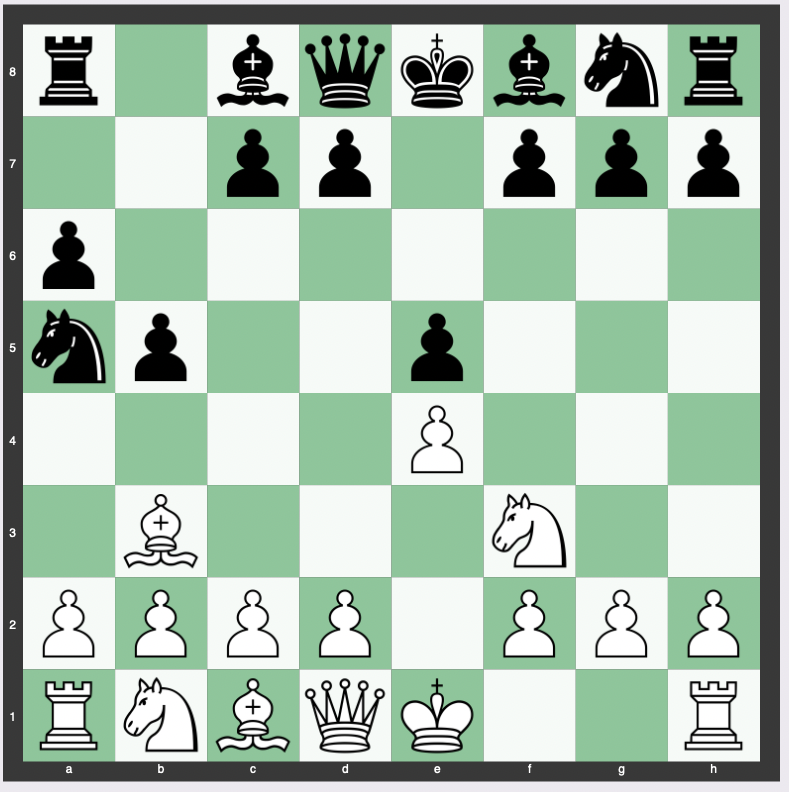The Norwegian Defense, a variation of the Ruy Lopez, an ancient and popular chess opening named after the 16th-century Spanish bishop Ruy López de Segura.
Below we provide an in-depth analysis of the Norwegian Defense, its strategic advantages, variations, historical evolution, and its suitability for beginners and intermediate players, as well as its usage at the grandmaster level.
Move Order of the Norwegian Defense
The Norwegian Defense is initiated by the moves 4.Ba4 b5 5.Bb3 Na5.

It aims to eliminate the white bishop on b3, a move considered by many to be a time-consuming strategy for Black.
The usual sequence continues with 6.0-0 d6 7.d4 Nxb3.
However, White can attempt an aggressive and speculative sacrifice with 6.Bxf7+?! Kxf7 7.Nxe5+, which aims to force the Black king out into the open.
Despite the initial shock, Black can maintain a steady position with accurate play, all the while keeping hold of the extra piece.
Theory, Strategy, and Purpose of the Norwegian Defense
The Norwegian Defense’s primary purpose is to remove the White’s light-squared bishop from the game, thus somewhat reducing White’s control over the center.
This strategy does require a significant amount of time to accomplish, as Black must move the knight twice to capture the bishop and then recapture after the white d-pawn’s advance.
However, the removal of the bishop can simplify Black’s position and reduce the immediate threats.
Variations of the Norwegian Defense
Within the Norwegian Defense, there are a few notable variations.
One key variation arises after White plays 6.Bxf7+?! Kxf7 7.Nxe5+, an interesting speculative sacrifice.
This gambit forces the Black king out into the open, causing potential danger.
But with precise play, Black can manage to maintain a solid position and preserve the extra piece.
History of the Norwegian Defense
The Norwegian Defense has been known since the 1880s but saw a resurgence in popularity in 1901 when Carl Schlechter reintroduced it.
The defense’s “Norwegian” connection came into play when Svein Johannessen, a Norwegian player, adopted this line in 1957.
It was further popularized by other Norwegian players, including Simen Agdestein.
Despite its namesake, Mark Taimanov, a Soviet Grandmaster, was noted for successfully employing this variation in the 1950s.
It remains a less common choice, but it has made its presence felt on the international stage.
Is the Norwegian Defense Good for Beginners or Intermediates?
The Norwegian Defense is generally considered more suitable for intermediate players due to its time-consuming strategy and the need for accurate play to avoid early disadvantage.
For beginners, understanding and executing such strategy might be a challenge.
That said, learning this defense could potentially offer a greater understanding of the game’s intricacies, particularly regarding positional play and strategic sacrifices.
How Often Is the Norwegian Defense Played at the Grandmaster Level?
While the Norwegian Defense is not the most popular choice at the grandmaster level, it has been adopted by a number of grandmasters, with Mark Taimanov being one of the most notable examples.
Its rarity can sometimes serve as a surprise weapon, catching opponents off guard.
Despite this, most grandmasters prefer to stick with mainline openings and defenses that offer more standard play.
Surprise Weapon Against the Ruy Lopez (Norwegian Variation)
FAQs – Norwegian Defense
1. What is the Norwegian Defense?
The Norwegian Defense is a specific sequence of moves in the game of chess, used by the black player.
It’s also known as the Taimanov or Wing Variation. The sequence is defined as 3…a6 4.Ba4 b5 5.Bb3 Na5 within the context of the Ruy-Lopez opening.
The strategy behind these moves is to attempt to eliminate the white bishop, though this is generally considered to take up too much time for the black player.
2. What is the usual continuation after the initial Norwegian Defense sequence?
After the initial sequence of the Norwegian Defense (3…a6 4.Ba4 b5 5.Bb3 Na5), the typical continuation is 6.0-0 d6 7.d4 Nxb3.
This sequence of moves is aimed at developing black’s pieces and removing white’s light-squared bishop.
3. What is the speculative sacrifice in the Norwegian Defense?
A speculative sacrifice in the Norwegian Defense is a risky strategy where white sacrifices a bishop in an attempt to disrupt black’s game.
Specifically, the move is 6.Bxf7+?! Kxf7 7.Nxe5+, which forces the black king out from its protective position.
However, with accurate play, black can maintain the balance while keeping the extra piece.
4. How did the Norwegian Defense gain its name?
The Norwegian Defense is named after its adoption and usage by notable Norwegian chess players, such as Svein Johannessen who started using the line from 1957, and later Simen Agdestein and other Norwegian players.
Despite the defense being known since the 1880s and reintroduced by Carl Schlechter in 1901, it got its “Norwegian” name due to the consistent application by these players.
5. Who was Mark Taimanov and what is his connection with the Norwegian Defense?
Mark Taimanov was a Soviet grandmaster of chess, and he is linked to the Norwegian Defense as he used this specific variation with some success during the 1950s.
However, despite his success, the Norwegian Defense remained a less common or sideline strategy in the game of chess.
Conclusion
The Norwegian Defense, a unique and somewhat time-consuming strategy in chess, offers interesting dynamics in the battle for control over the board.
While not the most popular choice among grandmasters, it is an intriguing choice for intermediate players seeking to deepen their understanding of the game.
The defense’s rich history, variations, and strategic challenges make it an appealing exploration for those willing to venture off the beaten path of traditional chess openings.
Whether you’re a seasoned player looking to add variety to your game or an ambitious learner aiming to master the finer aspects of chess, the Norwegian Defense undoubtedly provides a challenging and rewarding journey into the heart of this timeless game.


